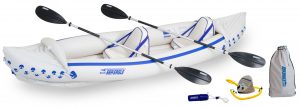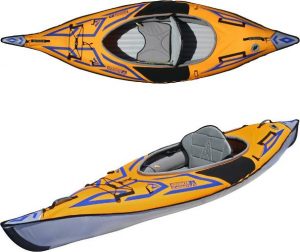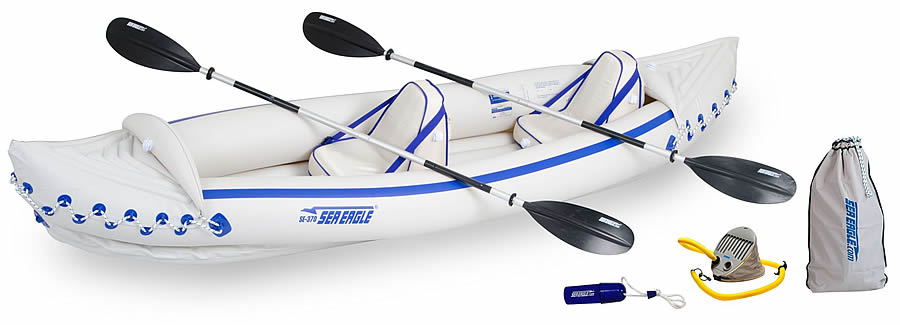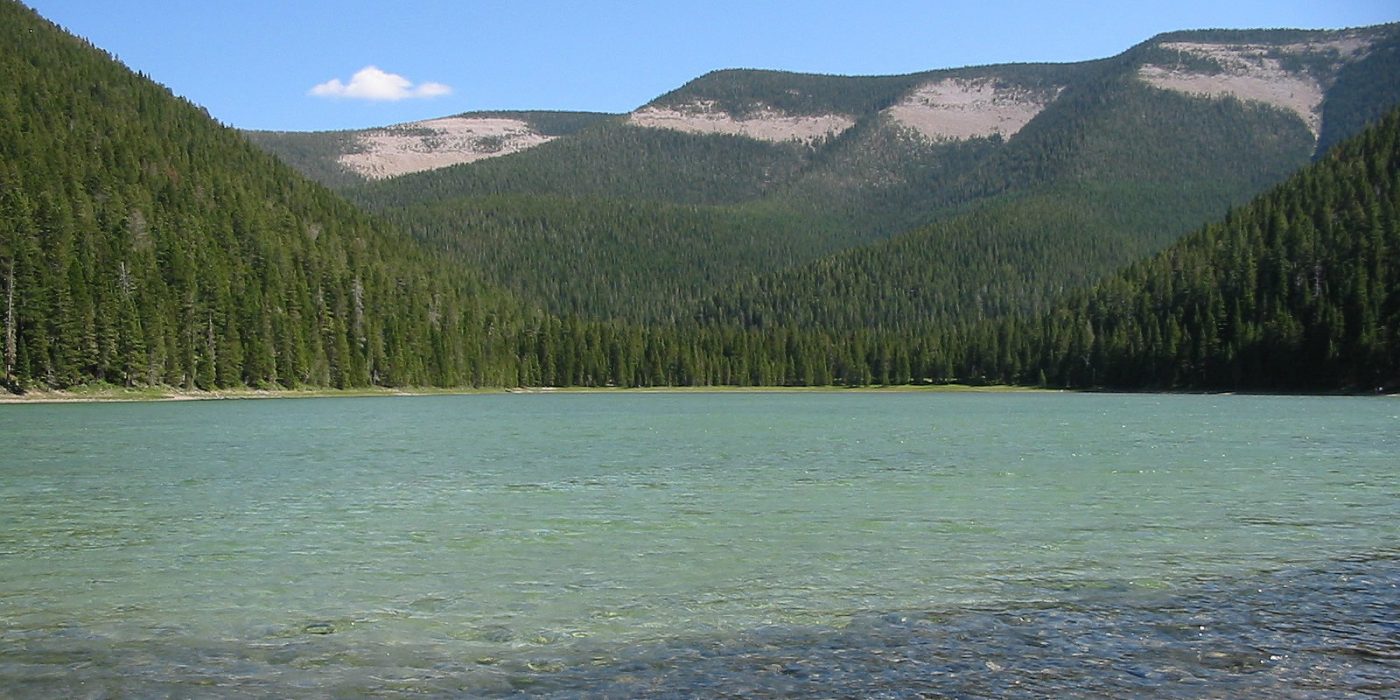Like many people, I started my adventure into the world of inflatable boats with a leak-prone inflatable kayak. Made by Sevylor, as a kid I used the kayak nearly throughout the summer. Friends and I would take the kayak out into the middle of the pond we lived on, toss anchor and then snorkel around or try to chase some fish into the boat.
Using that kayak was a blast.
Except for the continual leak problems. No doubt part of the problem was, well, we were kids. Nobody bothered to inform us how to properly inflate the boat. As such, with the clarity hindsight brings, I often over-inflated the boat, which certainly didn’t help keep the fabric or seams strong.
But there were, um, other “issues,” to use the politically correct word that’s so in vogue today. Without fail, the kayak would visit the local patching place after being put into storage for a while. Somehow leaks mysteriously developed during storage, despite being deflated.
Worse, the leaks developed at places where it was impossible to patch—the seams. Once a recreational inflatable kayak develops a leak at a seam, putting a permanent patch on the boat is nearly impossible.
So the inevitable result was a new kayak every year or two. My mom never enjoyed buying this “buffet of boats.” But the alternative, of course, was to have a bunch of kids cooped up inside. And what parent wants a bunch of screaming kids inside the house during the summer when they could be screaming outside?
Anyways, I bring these sordid tales of my childhood to light to highlight the opportunities and perils of owning a recreational inflatable kayak. They are fun, lots of fun.
But, if you get a cheap inflatable kayak, well, you’re problems are just beginning. You’ll spend tons of time chasing down leaks. And it’s most unlikely that the boat will survive more than a season or two of hard use. And it’s entirely possible that after a winter spent in storage the boat will have more holes than a moldy block of Swiss cheese.
In the world of recreational inflatable kayaks, you get what you pay for.
The purpose of this article is to help buyers interested in purchasing a recreational inflatable kayak buy the correct one for their needs and budget. So let’s get started.
Contents of this article:
What is a Recreational Kayak?
So let’s start with the basics—what is a recreational inflatable kayak? Basically, these types of kayaks are meant for day uses on lakes, sheltered ocean bays and relatively sedate rivers (no pounding whitewater).

A Sea Eagle 370 Sport Kayak is a perfect example of a recreational inflatable kayak. See more info about this kayak at Sea Eagle.
Recreational inflatable kayaks aren’t meant for long, overnight journeys through remote areas. The lighter fabric isn’t designed for harsh use.
Instead, think of recreational kayaks as a boat you’d take out for a day paddling around a nearby lake or floating a nearby river. Or a boat you’d give your kids so they could go play out on a nearby lake.
Can these kayaks be taken on overnight trips? Yes and no. Good quality kayaks can, although I’d limit overnight uses to paddles across lakes or on very sedate rivers. Lesser quality recreational inflatable kayaks, however, should never be taken on overnights due to the high risk of irreparable punctures or seam tears happening.
Overall, when you think of recreational inflatable kayaks, think fun! Think play! Whether you want to play on the lake, in the ocean waves or in the river nearby, a good quality recreational inflatable kayak is an ideal “play partner.”
Differences Between Recreational Inflatable Kayaks & Expedition Level Kayaks
It’s quite easy to spot the differences between these two types of kayaks. Here’s some key differences. Please read the Expedition Level Inflatable Kayak article to learn more about these kayaks.
Cost – Expedition level kayaks are much more expensive, easily double the price of even the best recreation kayaks.
Inflation Pressure – Expedition level inflatable kayaks are inflated to a high PSI (typically over 3PSI). The high PSI makes these boats very stiff. Fully inflated, the fabric won’t bend no matter how hard you push down on the side of the boat.
By contrast, recreational kayaks are inflated to a low PSI, typically just over 1PSI. These kayaks also aren’t inflated to maximum capacity. Instead, they are designed to “bend to the touch.” If you put your thumb on the boat and press down, the fabric should easily bend by about one-half inch or so.
Construction – Expedition kayaks are constructed of a very tough denier fabric that is also very thick. To the touch, these kayaks often feel “rough” to the skin. By contrast, recreational kayaks are constructed from a thinner PVC material, which is smooth to the touch.
Weight Capacity – Because of the high PSI in expedition level kayaks, a boat of similar size to a recreational kayak has a higher weight capacity.
Increased Weight – Expedition level kayaks typically weigh about 10-15 lbs more than a similarly sized recreational level kayak. The increased weight is because of the thicker fabric used to construct the boat. Thicker fabric = More Weight.
Benefits & Drawback of Recreational Inflatable Kayaks
Benefits
Price – Vary from $100 (junk kayaks) to $300-$500 (high quality). Much less expensive than high pressure, expedition level inflatable kayaks.
Lightweight – The thinner material makes these boats very lightweight and easy to carry, both when inflated and deflated. On average, they are about 15 pounds less than a comparably sized expedition level inflatable kayak.
Easy to Setup – Unroll/unpack the kayak, pump in the air and go. It really is that simple. While expedition level kayaks aren’t much more difficult or time consuming to setup, it does take longer to inflate them.
Portability – The lightweight and compact package size of these kayaks allows for extreme portability. While the portability does vary among manufacturers, many kayaks – such as those from Sea Eagle – pack down into a tiny package. This small package can be stuffed into any trunk or small storage space of an RV.
Drawbacks
Weather Limitations – Because of the fabric used on these boats, it is not advised to use these boats when the air temperature is below freezing. At below freezing temperatures, the fabric starts to become brittle. The colder the air temperature, the more brittle it becomes.
Less Resistance to Leaks & Punctures – How puncture prone these boats are depends almost entirely on two things—the company that made them and how you take care of them. Very cheap inflatable kayaks are made from thin material that is easily punctured. Worse, these kayaks start to develop tears at the seams—which essentially destroys them.
Yet not all recreational inflatable kayaks are like these. The Sea Eagle 330 and Sea Eagle 370 are made from the exact same material that my Sea Eagle 8 inflatable raft is. That raft is 15 years old (as of this writing), and has not once developed a single leak. The reason is because the seams are electrically welded and the fabric is thicker than what’s found on cheaper boats.
If you follow inflation and storage instructions, high-quality recreational inflatable kayaks such as those from Sea Eagle or Advanced Elements should go many years without developing a single leak. And should leaks develop, those leaks won’t be on the seams and are easy to repair.
Whitewater Limitations – Few recreational inflatable kayaks are meant for real whitewater (Class III or above). Typically, the fabric material is too thin to withstand the beating whitewater inflicts on a boat or the pounding the boat takes as it bounces into or over rocks.

Advanced Elements Sport Kayak. Available from REI.
However, there are exceptions. The Sea Eagle 330 and 370 are designed for Class III whitewater. The thicker material won’t develop a leak no matter how contorted the boat comes due to whitewater. Moreover, when it comes to rocks, these kayaks are like my raft—they tend to “bounce” off rocks. Since these kayaks are low-pressure kayaks, when the boat runs into a rock the fabric compresses and then bounces the boat off or over the rock.
Another limiting factor for running whitewater with recreation kayaks is that few of them have drain valves. Drain valves allow water that enters the boat to drain out. As far as I know, only the Sea Eagle Sport Kayaks (the SE 330 and SE 370) have drain valves.
Weight Capacity – Most recreational inflatable kayaks are smaller than expedition level kayaks. The smaller the boat is, the less air there is. Less air = reduced weight capacity.
For day trips across lakes or down a local river, the reduction in weight capacity isn’t an issue. However, if you want to take your boat on overnight trips, the combination of reduced weight capacity and less internal space to store dry bags and other gear is a limiting factor.
Boats that are packed to near their weight capacity, while they won’t sink into the depths of the lake, have all the handling characteristics of the Titanic. That is, they are slow—very slow—to turn and tiring to paddle long distances.
Perfect Uses for Recreational Inflatable Kayaks
Fishing & Paddling on Lakes and Ponds
Weather you just want to head out for a day of fun paddling on your local lake, or take a tour of a scenic lake such as Lake McDonald in Montana, a recreational kayak is a fine choice. A two-person boat has plenty of space for whatever gear you need for day trips.
These kayaks are also solid, albeit not great, fishing platforms. I spent my childhood fishing from these kayaks. Fly fishing is somewhat challenging from these boats due to the low seating position and high pontoons, but spin fishing is a breeze. If you’re looking for a kayak specifically for fishing, read the Inflatable Fishing Kayak article on this site.
Note – If you buy a recreational level kayak for lake paddling, be doubly sure the boat comes with skegs. Skegs allow the boat to track straight across the water, instead of “yawing” back and forth. This is especially important for solo paddlers.
Day Floats on Rivers
These kayaks work extremely well for day floats on relatively sedate rivers. Even the cheapest inflatable kayak can tackle Class II rapids without being destroyed, while better quality kayaks can run Class III rapids.
Playing in Ocean Waves
These kayaks are often seen paddling around in smaller ocean waves. In particular, the Sea Eagle series of kayaks are ideal for this since they are self-bailing. If a wave happens to break and water pours in the boat, the kayak won’t fill up with water.
A Boat for the Kids
Perhaps you’re a parent and find yourself in the same situation my Mom was in when I was younger. You need a boat for the kids. If that’s the case, recreational kayaks are an absolutely ideal choice.
Kids can easily paddle these boats. If they capsize it (which they will, both deliberately and on occasion accidentally), they are so lightweight that they are easy to turn over (even while the kid is in the water) and then to climb back into the boat (I did this countless times every day).
Unless you want to buy an inflatable kayak every year or two like my Mom was forced to do, however, I’d advise two things. First, get a better quality kayak that can stand up to the rigors of kids. And secondly, young kids are unlikely to properly inflate the boat. Almost certainly, they’ll over-inflate the boat—trying to make it “rock solid”—if left to their own devices.
So instead, I’d suggest that an adult (aka…you) inflate the boat for them. Then just leave the boat inflated throughout the summer, if that’s possible for your living situation.
Good Brands of Inflatable Recreational Kayaks
I’ve seen too many cheap inflatable kayaks fail over the years, both those I’ve owned and boats owned by friends. So, I’ll state my own views on the matter. The following brands make high-quality recreation level inflatable kayaks that won’t fail after a season or two of hard use.
Sea Eagle – Makers of my own Expedition inflatable kayak (the Sea Eagle 380x) and my inflatable raft (a now discontinued SE 8). Their recreational level inflatable kayaks, called “Sport Kayaks,” are made from the same material as my raft is. With proper care, and perhaps a wee bit of luck, these kayaks will last a lifetime of hard use.
More Info and Photos about the Sea Eagle 370 Sport Kayak at Sea Eagle.Com
More Info and Photos about the smaller Sea Eagle 330 Sport Kayak at Sea Eagle.Com
Advanced Elements – Their kayaks are more expensive than Sea Eagle’s. These kayaks are very durable, but do tilt towards more “whitewater use.” Their kayaks more closely resemble hard-shell kayaks in that they have a cockpit, compared to Sea Eagle kayaks which really resemble a canoe more than a kayak. Advanced Elements kayaks are available through REI and Amazon.
Aquaglide – Another excellent recreation kayak. These kayaks more closely resemble Sea Eagle kayaks, in that they look more like inflatable canoes than a true kayak. Somewhat expensive, these kayaks will last a lifetime with proper care. These kayaks are also available through REI and Amazon.
If You Want My Advice
In terms of value per dollar spent, I believe Sea Eagle Sport inflatable kayaks (their recreational level kayak) provide the most bang for the buck. These inflatable kayaks can run whitewater, won’t fall apart after a hard season of use, have a good weight capacity, can withstand the claws of your dog, are lightweight and easy to transport, and are very versatile.

The Sea Eagle 370 is the perfect blend of features for a very affordable price.
In short, they are the perfect kayak for wide variety of “day to day” uses. And they can also safely be taken on overnight journeys across lakes and down relatively sedate streams.
If you decide to go with a Sea Eagle recreational inflatable kayak, the first decision to make is to decide whether to go with the larger SE 370 or the smaller SE 330. Let me offer some suggestions.
First decide the maximum number of people/animals who plan to be in the boat at a time. One? One + one dog? Two? Two + one kid? Two + one dog?
If you’re answer comes to two or more to any of those questions, I’d highly suggest going with the SE 370. The increased weight capacity and greater internal room makes paddling more comfortable. Moreover, the larger boat is more versatile. The extra capacity and storage space make it far easier to store gear for overnight trips.
Solo paddlers, on the other hand, unless they plan to pack lots of gear or have a couple of dogs along, can stick with the SE 330. The shorter length of the SE 330 makes it easier to control for solo paddlers, particularly those who plan to take the boat through whitewater.
Finally, the cost differential between the SE 330 and SE 370 is quite minor (usually no more than $30 to $50, depending on package), so it only makes sense to purchase a larger kayak if you someday foresee the need for it.
Once you decide on the model, the next step is to determine which package to go with. Sea Eagle sells all their boats in packages. Every package is “ready to go” and contains everything one needs to head out to the water.
However, each package contains varying components. Base packages generally contain the basic level seats, which you may or may not like. Additionally, depending on the promotions Sea Eagle might happen to be running, the base package may, or may not, include a carry bag.
For this reason, I suggest spending the extra $50 or so and upgrading to either their “Pro” or “Deluxe” package. These packages typically contain better seats and always contain a carry bag.
Don’t poo-poo the importance of the carry bag, either. A carry bag is vital to protect the kayak during transport or long periods of storage. Moreover, the carry bag keeps all components of the boat together. With no carry bag, it is far too easy to misplace parts of the boat (aka, the pump or paddles) during transport or even long periods of storage.
More Information about the Sea Eagle 370 at Sea Eagle.Com
More Information about the Sea Eagle 330 at Sea Eagle.Com
Instruction Manual
- Instruction Manual for the Sea Eagle 330/370 Inflatable Kayaks (.pdf file. May be slow to load)
Video’s
How to Setup the Sea Eagle Sport Kayak
Owner On Using Their Kayak
Using Sea Eagle Sport Kayaks in Class II & Class III Whitewater
Good video shows the type of whitewater the Sport Kayaks’s from Sea Eagle are suited for.
Running Class IV Whitewater in a Sea Eagle 380x
This video shows strong Class III and Class IV whitewater…or where you do NOT want to take a Sea Eagle 330/370. Kayak used in video is the same expedition kayak I own, the Sea Eagle 380x.
More information about Expedtion Level Inflatable Kayaks on Big Sky Fishing.Com
More information about the Sea Eagle 380x at Sea Eagle.Com


